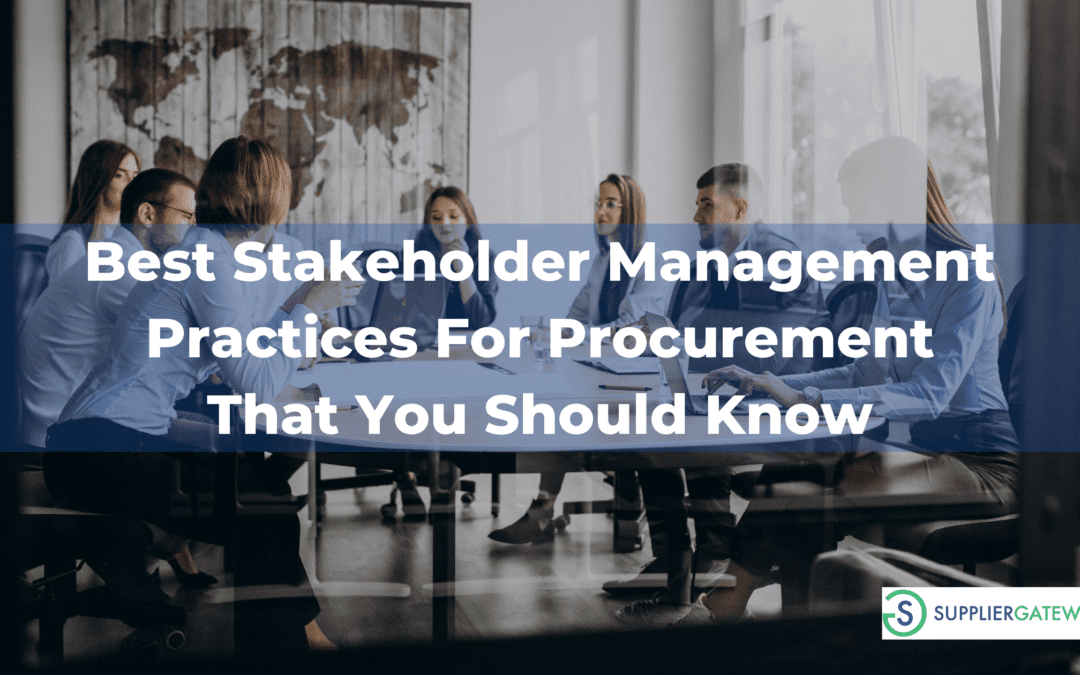
In an enterprise, Procurement’s job is to ensure stakeholders get the right goods or services provided by suppliers, on time and at the right quality level. Procurement success is tied to how well you work with the stakeholders and what you can do to help them to succeed in what they want to achieve. Their success is not only the company’s success but also yours. As such, it’s crucial for Procurement to have a good stakeholder management strategy.
Who are the stakeholders in the procurement process?
A stakeholder is an individual or organization that benefits from or is affected by the project, product or service. In procurement, stakeholders are broadly divided into two major categories – Internal and External stakeholders.
- Key Internal Stakeholders in a procurement activity include those who operate within the organization, such as procurement managers, budget owners, manufacturing, finance and legal team.
- Key External Stakeholders are those who contribute to the project but are not directly connected to the organization. Suppliers and other partners are considered external stakeholders.
Why Does It Matter?
Many surveys show that stakeholders often do not cooperate and only give feedback once a major issue arises. This has caused challenges to procurement to successfully do their job due to the limited comprehension of what value/ expectations the stakeholders want.
This article lists six practices that successful procurement professionals leverage to build a solid relationship with stakeholders.
-
Plan Out Stakeholder Engagement Strategy:
First of all, it’s vital to plan out an engagement strategy and communication plans. By doing so, you identify research your key stakeholders, how much support you will need for the project, and what stakeholders’ communication preference is. Skipping this step directly impacts your outcome, such as missing stakeholders, identifying wrong people as stakeholders, budget variances, or worse – your project can fail.
-
Understand Your Stakeholder’s Requirements And Speak Their Language
Do your homework before talking to stakeholders. Many stakeholders care about cost and savings, but you may be surprised to find it’s their secondary importance. Start building a relationship first, have an initial exploratory conversation to understand their goals and expectations for that project/activity. What you want is to become an expert that stakeholders will ask relevant questions at a later time.
Don’t forget to speak the stakeholder’s language instead of using unattractive procurement jargon. Modifying the ways in which buyers express opinions or ideas is a more compelling way to build an interpersonal rapport.
Once you build a strong relationship, everything you care about, such as cost or saving, will come later. Otherwise, you may impact their interest right from the beginning.
-
Internally Prioritize Importance And Relevance of Key Stakeholders:
Not all stakeholders are equally important in any given project. There are two important criteria to help you properly prioritize the needs of stakeholders – the level of interest and influence. As a rule of thumb, those with a high level of interest and influence are considered key stakeholders. Conversely, those with a low level of interest and influence only have a minor impact on decision-making.
-
Be Proactive And Early Engagement:
It’s critical for procurement professionals to drive a culture of regular communication and mutual collaboration across the organization. These activities include joining the regular meeting with stakeholder’s departments, joining the kick-off meeting to set the project’s foundation, etc.
The earlier you engage with key stakeholders, the better you’re involved in the negotiation process. Positive working relationships add higher value to the outcome and be more likely to be a part of the project’s decision-making process for any changes.
-
Transparent Procurement Activities And Invest In The Right Tools:
Being transparent in procurement activities is one of the best ways to build trust and enhance clear communication with your stakeholders. Everything is made more accessible and efficient with the right tools. Take the time to explore what technology options are available out there and what solutions these technologies offer are the best for your organization. To identify that, you need to understand what obstacles and bottlenecks that your organization is facing.
-
How About External Stakeholders?
After discussing with stakeholders and defining what needs to be done, it’s time to implement your procurement plan. It includes identifying, shortlisting, selecting and acquiring suitable goods or services from multiple third-party vendors through direct purchase, competitive bidding, receiving and fulfilling payment, etc., while ensuring timely delivery in the right quality and quantity.
It’s a daunting process for procurement professionals. Fortunately, digital technologies allow you to easily manage suppliers, quickly respond to market demand at a much lower cost than doing it manually. With the right pick of software, procurement is likely to have a game-changing impact across the entire organization.
SupplierGateway’s easy-to-use, instant-on and inexpensive software facilitates the entire procurement and supplier management process to increase operational efficiencies, reduce costs and streamline communication with suppliers. A portal administrator can tailor custom business rules, create unique workflows, and modify user roles and permissions. In addition, the software is configured to quickly accommodate any necessary changes in your project to ensure you source and diversify the best-qualified suppliers while delivering your project on time and within budget.
To learn more, please visit our website.












